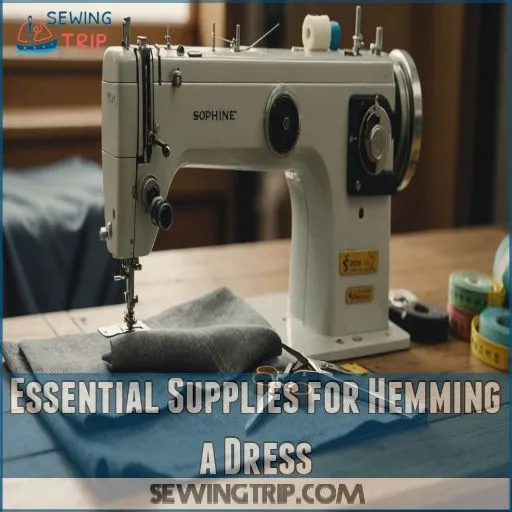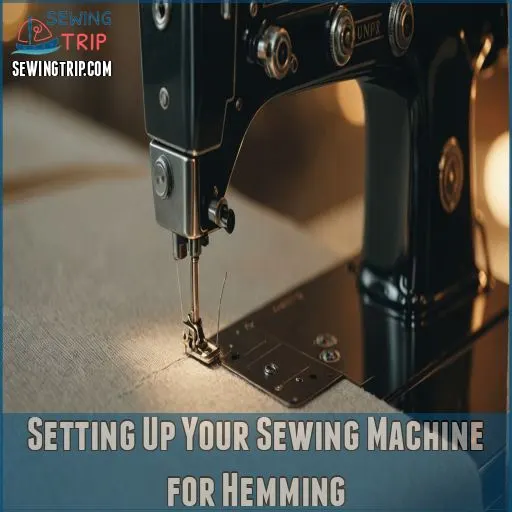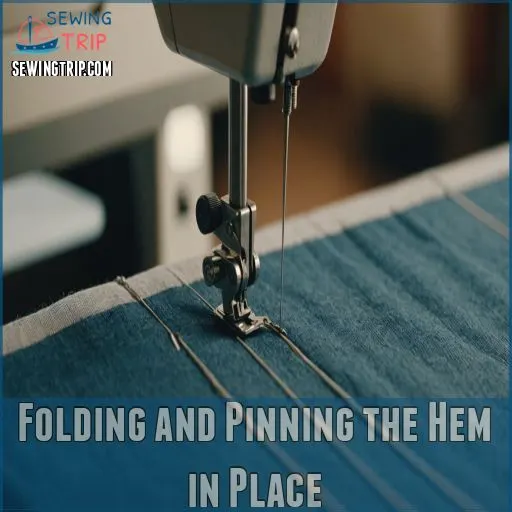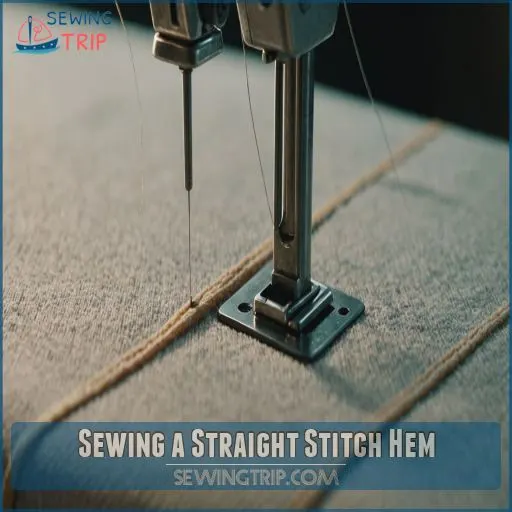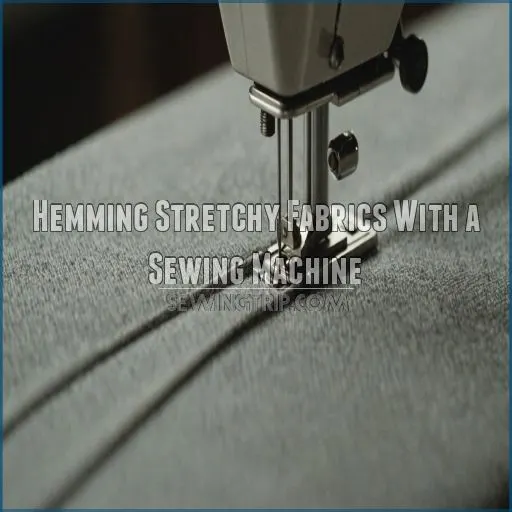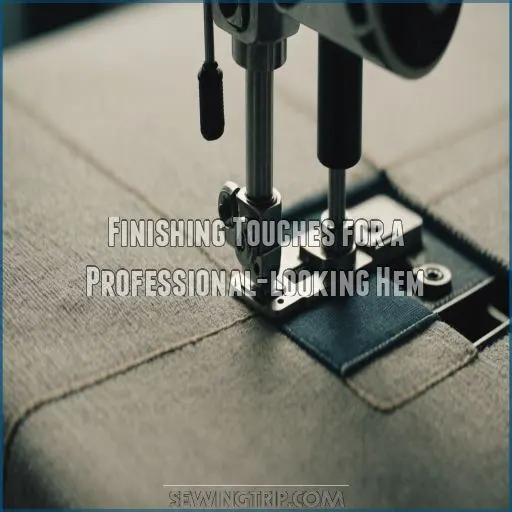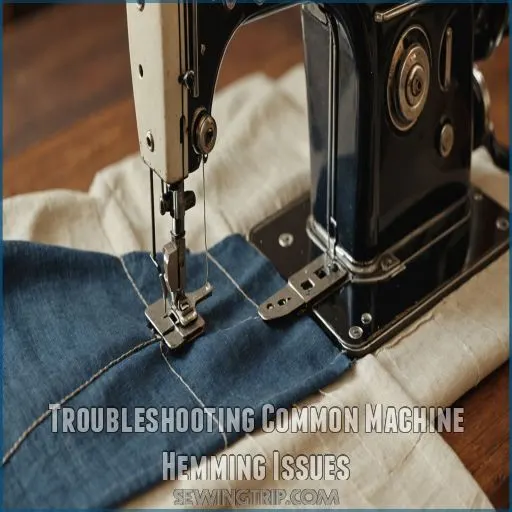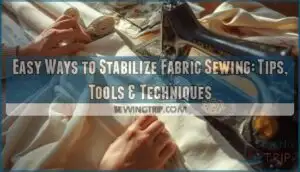This site is supported by our readers. We may earn a commission, at no cost to you, if you purchase through links.
 Hemming a dress with a sewing machine is as easy as pie—once you’ve got the right setup!
Hemming a dress with a sewing machine is as easy as pie—once you’ve got the right setup!
Start by choosing a thread that matches your fabric, and don’t forget a needle suited to your dress’s material.
Use a measuring tape and tailor’s chalk to mark the hem, then trim any excess fabric.
With your sewing machine ready, stitch a straight line along the hem, remembering to backstitch at the start and finish.
Press the hem for a neat, polished look.
Voilà, you’ve mastered hemming! Stay tuned for tips on handling stretchy fabrics and achieving invisible hems, ensuring a flawless finish.
Table Of Contents
- Key Takeaways
- Essential Supplies for Hemming a Dress
- Preparing Your Dress for Machine Hemming
- Choosing the Right Stitch for Your Dress
- Setting Up Your Sewing Machine for Hemming
- Folding and Pinning the Hem in Place
- Sewing a Straight Stitch Hem
- Creating an Invisible Hem With a Machine
- Hemming Stretchy Fabrics With a Sewing Machine
- Finishing Touches for a Professional-looking Hem
- Troubleshooting Common Machine Hemming Issues
- Frequently Asked Questions (FAQs)
- Conclusion
Key Takeaways
- Don’t underestimate the power of preparation—grab the right tools like fabric shears and tailor’s chalk, much like a knight readying his armor. They’re your trusty sidekicks for nailing that perfect hem.
- Remember, the sewing machine is your best friend, but a friend needs the right accessories. Choose the correct needle, whether it’s a ballpoint or sharp needle, and match your thread to the fabric. It’s like setting up the perfect dance partnership!
- When dealing with different types of fabric, choose your stitches wisely. For stretchy fabrics, zigzag stitches are like the elastic band to your pants, while blind stitches invisibly hug your fancy garments.
- Take a deep breath and embrace the pressing—it’s not just ironing; it’s your dress’s yoga session, stretching out any wrinkles to ensure your hem’s smoother than a jazz sax solo.
Essential Supplies for Hemming a Dress
Before you start hemming your dress, gather all the essential tools you’ll need for a smooth sewing experience.
From your trusty sewing machine to the perfect thread match, we’ll cover everything you need to tackle this project like a pro.
Sewing Machine and Appropriate Needles
Your trusty sewing machine is the star of the show for hemming dresses.
But don’t forget its sidekick – the right needle!
Choose a needle that’s compatible with your fabric: universal for most materials, ballpoint for knits, or a sharp for silks.
Remember, a dull needle is like trying to cut paper with safety scissors – frustrating and ineffective.
Keep a variety on hand to tackle any hemming challenge.
Thread Matching the Dress Fabric
Now that you’ve got your machine ready, let’s talk thread! Picking the right thread is like finding the perfect dance partner for your fabric. You want a match made in sewing heaven.
- Color: Go for an exact match or slightly darker shade
- Weight: Light fabrics need fine thread, heavy fabrics need sturdier options
- Fiber: Cotton for natural fabrics, polyester for synthetics
Remember, the right thread can make or break your hem. Choose wisely!
Scissors and Fabric Shears
After matching your thread, let’s talk about cutting tools. You’ll need two types: regular scissors and fabric shears.
Fabric shears are your best friends for clean, precise cuts on dress hems. Keep them sharp and use them only on fabric – no paper!
Regular scissors work for trimming threads.
Remember, a clean cut is half the battle in achieving a pro-looking hem.
Measuring Tape and Tailor’s Chalk
Got your fabric scissors ready? Great! Let’s grab your measuring tape and tailor’s chalk.
These tools are your best friends for nailing that perfect hem length. Here’s why they’re the dynamic duo of dress hemming:
- Measure twice, cut once (grandma was right!)
- Mark with precision, no guesswork needed
- Tailor’s chalk vanishes like magic after ironing
- Measuring tape doubles as a makeshift ruler
- Both tools fit snugly in your sewing kit
With these in hand, you’re one step closer to hemming like a pro!
Pins and Ironing Equipment
While pins might seem like tiny troublemakers, they’re your secret weapon for a flawless hem.
You’ll need sharp, thin pins that won’t leave marks, and a trusty iron to press those crisp edges.
Let’s break down your pinning and pressing arsenal:
| Tool | Purpose | Pro Tip |
|---|---|---|
| Glass-head Pins | Heat-resistant marking | Use for delicate fabrics |
| T-pins | Secure thick fabrics | Great for denim hems |
| Pressing Cloth | Protect delicate fabrics | Use silk organza for sheer fabrics |
Preparing Your Dress for Machine Hemming
Before you fire up your sewing machine, you’ll need to prep your dress for the perfect hem, just like you would when preparing for hemming dress slacks.
Get ready to measure, mark, and make that initial fold – it’s like setting the stage for your hemming performance, and trust us, you want a standing ovation at the end!
Measuring and Marking the Desired Hem Length
Countless dresses, one perfect length! To measure and mark your desired hem, you’ll need a keen eye and a trusty tape measure.
- Slip on the dress and your go-to shoes
- Stand straight in front of a full-length mirror
- Pin the hem at your ideal length, considering your body shape and the dress style
Remember, you’re the artist of your own fashion masterpiece – don’t be afraid to experiment until it feels just right!
Calculating and Marking the Hem Allowance
Ready to conquer that hem allowance? Let’s get started! Your hem allowance is important for a polished finish.
Here’s a quick guide to help you nail it:
| Fabric Type | Desired Look | Recommended Allowance |
|---|---|---|
| Lightweight | Delicate | 1/2 inch |
| Medium | Standard | 1 inch |
| Heavy | Structured | 1 1/2 inches |
| Stretchy | Flexible | 3/4 inch |
| Full Skirt | Flowy | 2 inches |
Measure and mark your allowance carefully, adjusting for your dress’s shape and weight. You’ve got this!
Trimming Excess Fabric if Necessary
Now that you’ve marked your hem allowance, it’s time to trim away excess fabric.
Don’t go scissor-happy just yet! Carefully check if trimming is necessary – some dresses might not need it.
If you do need to cut, use sharp fabric shears for clean edges.
For curved hems, make small V-shaped notches to help the fabric lay flat.
Remember, you can always trim more, but you can’t add fabric back!
Pressing the Initial Fold Line
With your excess fabric trimmed, it’s time to press that initial fold line.
Grab your trusty iron and get ready to tame those fibers!
Set up your ironing board and adjust the heat based on your fabric type.
For delicate materials, use a pressing cloth to protect them.
Create a crisp crease by pressing firmly, moving slowly along the hemline.
Remember: a well-pressed fold is half the battle won!
Choosing the Right Stitch for Your Dress
You’re ready to hem your dress, but which stitch should you use?
Let’s explore the best stitches for different fabrics and finishes,
so you can achieve pro-level results without breaking a sweat (or your sewing machine).
Straight Stitch for Most Fabrics
When it comes down to choosing the right stitch for your dress, the straight stitch is your go-to workhorse for most woven fabrics.
It’s like the trusty sidekick in your hemming adventure!
Adjust your stitch length based on fabric weight – shorter for delicate materials, longer for heavier ones.
Don’t forget to match your thread and needle to your fabric for a polished finish.
Zigzag Stitch for Stretchy Materials
While straight stitches work wonders for most fabrics, stretchy materials need a bit more TLC.
Enter the zigzag stitch – your new best friend for hemming that slinky jersey dress!
This nifty stitch allows the fabric to stretch without snapping threads.
Adjust your machine’s tension and use a ballpoint needle to prevent puckering.
Remember, practice makes perfect, so test on scraps before tackling your dress!
Blind Hem Stitch for Invisible Finish
Craving an invisible finish for your dress hem? The blind hem stitch is your answer!
This sneaky little stitch hides in plain sight, giving your dress a polished look without visible stitching.
You’ll need a blind hem foot for your machine, but trust us, it’s worth it.
Adjust your stitch width for the best invisibility, and you’ll be rocking a pro-level hem in no time!
Decorative Stitches for Embellished Hems
Four decorative stitches can transform your dress hem from mundane to magnificent.
Let your creativity shine with these eye-catching options:
- Scalloped edges for a whimsical, feminine touch
- Zigzag patterns that add a playful bounce
- Floral motifs to bring a touch of nature to your hem
- Geometric designs for a modern, edgy look
- Contrasting thread colors to make your hem pop
You’ll be amazed at how these embellishments can elevate your dress from homemade to haute couture!
Setting Up Your Sewing Machine for Hemming
You’re almost ready to hem your dress, but first, let’s get your sewing machine prepped for success.
Properly setting up your machine is like giving yourself a secret weapon – it’ll make your hemming smoother than a well-ironed pillowcase and help you avoid those dreaded wonky stitches.
Selecting the Appropriate Presser Foot
With the right presser foot, you’ll be hemming like a pro in no time.
Your sewing machine’s all-purpose foot works for most hems, but specialized feet like a jeans foot can take your skills up a notch.
Consider a blind hem foot for invisible finishes or a narrow rolled hem foot for delicate fabrics.
Don’t forget to check your foot’s compatibility with your machine – it’s a real game-changer!
Adjusting Stitch Length and Width
Two key players in your hemming game: stitch length and width.
You’ll want to adjust these based on your fabric’s thickness and the stitch type you’re using.
For most hems, a medium stitch length (around 2.5mm) works like a charm.
If you’re going for a running stitch, keep it short and sweet.
Herringbone? Widen that stitch for a bold statement.
Testing Settings on Scrap Fabric
Now that you’ve adjusted your stitch settings, it’s time to put them to the test.
Grab a scrap of fabric similar to your dress and let’s play around!
This is your chance to fine-tune everything before tackling the real deal.
Experiment with different stitch lengths, tensions, and pressures.
You’ll be surprised how much fabric type affects your machine’s performance.
It’s like finding the perfect dance partner for your dress!
Threading the Machine Correctly
You’ve nailed those test stitches on scrap fabric—high five! Let’s tackle threading your machine like a pro.
Start by winding that bobbin tight and popping it in place.
Next, guide your thread through the tension discs, take-up lever, and needle eye.
Double-check your needle type matches your fabric.
Remember, a well-threaded machine is your secret weapon for flawless hems.
Ready to stitch up a storm?
Folding and Pinning the Hem in Place
You’re almost ready to start stitching, but first, let’s tackle the important step of folding and pinning your hem.
This part’s like giving your dress a well-fitted hug – it sets the stage for a polished finish that’ll make you look like a pro seamstress (even if you’re still figuring out which end of the needle to thread).
Creating a Single or Double Fold Hem
Now that you’ve set up your machine, let’s tackle folding that hem!
Fabric choice plays a big role here.
For lightweight dresses, a single fold hem is your best friend.
Simply press the edge up once and you’re golden.
Heavier fabrics? Go for a double fold to keep things neat and tidy.
Remember, pressing is key – it’s the secret sauce for a pro-looking finish!
Pinning Perpendicular to the Hemline
After folding your hem, it’s time to secure it with pins.
place pins perpendicular to the hemline, not parallel.
This method keeps your fabric from shifting and makes removing pins a breeze as you sew.
Space pins about 2-3 inches apart, and don’t be shy about using extra pins on tricky areas like curves.
It’s like giving your hem a temporary facelift!
Ensuring Even Distribution of Fabric
With your pins in place, it’s time to tame that fabric! Ensuring even distribution is like conducting an orchestra – every section needs to play in harmony.
As you fold and pin, keep these pro tips in mind:
- Gently ease fullness with your fingertips
- Divide the skirt into quarters for balance
- Use a ruler to check hem depth consistency
- Adjust gathers for a smooth silhouette
- Pin parallel to the fold for better control
Remember, a well-distributed hem is the secret sauce to a polished look. Your dress will thank you!
Dealing With Curved or Full Skirt Hems
When tackling curved or full skirt hems, you’re in for a fun challenge! Let’s get into some pro tips to make your life easier:
| Technique | Purpose | Pro Tip |
|---|---|---|
| Ease stitching | Shapes fabric | Use longer stitch length |
| Clipping | Reduces bulk | Cut notches every 2 inches |
| Gradual pinning | Distributes fullness | Work in small sections |
Remember, patience is key. You’re not just hemming; you’re sculpting fabric into a masterpiece. Take your time, and soon you’ll be handling curves like a pro!
Sewing a Straight Stitch Hem
You’ve prepped your dress and set up your machine, now it’s time for the fun part – actually sewing the hem!
With a steady hand and a few pro tricks up your sleeve, you’ll be stitching like a seasoned pro in no time.
Positioning the Fabric Under the Presser Foot
Ready to get started with hemming? Let’s get that fabric under your presser foot like a pro!
Slide the folded edge right up to the needle, aligning it with your chosen seam allowance guide.
Double-check your foot pressure – you want just enough to keep things smooth without squishing your fabric.
Position the needle to catch both layers perfectly.
Now you’re set for stitch success!
Guiding the Fabric as You Sew
Now that your fabric’s in position, let’s get sewing!
Keep your hands light on the fabric, guiding it gently—think of it as a dance partner you’re leading across the floor.
Don’t push or pull; let the feed dogs do the heavy lifting.
Keep an eye on your speed and tension, adjusting as needed.
Remember, slow and steady wins the race!
Maintaining Consistent Seam Allowance
To achieve a polished hem, maintaining consistent seam allowance is really important.
Keep your eye on the edge of the presser foot as it aligns with the fabric edge – it’s your trusty guide.
Adjust the presser foot pressure if your fabric’s being stubborn.
Remember, even fabric flow is key to nailing that perfect stitch length.
Don’t sweat if it’s not flawless immediately; practice makes perfect!
Backstitching at Start and End Points
You’ve nailed keeping that seam allowance consistent.
Let’s lock those stitches in place! Backstitching is like giving your hem a firm handshake – it makes sure your hard work won’t unravel.
- Sew forward 3-4 stitches, then hit reverse
- Go back over those stitches, then forward again
- Adjust stitch length for stronger reinforcement
- Don’t forget to backstitch at both ends of your hem
This simple trick will have your dress hem holding strong through countless twirls and spins, just like a well-sewn suit pant hem!
Creating an Invisible Hem With a Machine
Want to give your dress a polished look without visible stitching?
Creating an invisible hem with your sewing machine is easier than you might think, and it’ll make your homemade or altered dress look like it came straight from a boutique.
Folding and Pressing the Hem
Ready to give your dress an invisible hem? Let’s get started!
First, fold the raw edge under by your chosen hem allowance.
Press it crisp with your iron – no cutting corners here!
Next, fold again, tucking that raw edge inside.
Your trusty pressing tools are your best friends for a sharp crease.
Remember, different fabrics may need special TLC, so adjust your technique accordingly.
Using a Blind Hem Foot
It may seem tricky at first, using a blind hem foot is your secret weapon for invisible hems.
This nifty attachment grabs just a smidge of fabric as you sew, creating a nearly imperceptible stitch.
Think of it as your dress’s undercover agent, working behind the scenes to keep things polished.
Once you’ve mastered this tool, you’ll wonder how you ever lived without it!
Adjusting Stitch Width for Invisibility
Now that you’ve got your blind hem foot in place, let’s fine-tune that stitch width for a truly invisible hem.
Think of it as adjusting your camera’s focus – you want just enough to catch the fabric, but not so much it’s obvious.
- Start with a narrow width
- Test on scrap fabric
- Increase gradually if needed
- Check both sides for visibility
Remember, different fabrics may require tweaks, so don’t be afraid to experiment!
Sewing the Blind Hem Stitch
You’ve set the stage with perfect stitch width—let’s make that hem invisible!
Place your fabric under the blind stitch foot, aligning the fold with the guide.
As you sew, the needle should just catch the edge of the fold.
Keep your hands light on the fabric, guiding it gently.
Remember, different fabrics might need adjustments in tension or stitch length.
Don’t sweat it if you miss a few stitches—practice makes perfect!
Hemming Stretchy Fabrics With a Sewing Machine
Hemming stretchy fabrics can be tricky, but with the right techniques, you’ll be a pro in no time.
Stretchy material, whether you’re working with jersey, spandex, or any other stretchy material, these tips will help you create a polished hem that moves with your dress.
Using a Ballpoint Needle
Moving from invisible hems to stretchy fabrics, let’s talk about your secret weapon: the ballpoint needle. This little marvel glides between fabric fibers instead of piercing them, preventing snags and runs. It’s like giving your stretchy dress a gentle massage!
- Choose the right size: 70/10 for lightweight knits, 80/12 for medium-weight
- Replace often: Dull needles can damage fabric
- Adjust tension: Start looser and fine-tune as you go
Selecting Appropriate Stretch Stitches
Tackle stretchy dress hems with stretch stitches! Choose the right stitch and your hem will move with you, not against you.
| Fabric Type | Recommended Stitch | Needle Size |
|---|---|---|
| Light Knit | Narrow Zigzag | 70/10 |
| Medium Knit | Triple Stretch | 80/12 |
| Heavy Knit | Overlock Stitch | 90/14 |
Remember, a good stretch stitch is like a yoga instructor – flexible, yet strong!
Applying Gentle Tension While Sewing
When sewing stretchy fabrics, it’s really important to maintain just the right amount of tension.
Think of it as walking a tightrope – too loose, and your hem will pucker; too tight, and you’ll end up with wavy seams.
Gently guide the fabric through your machine, allowing it to feed naturally.
If you’re struggling, try adjusting your presser foot pressure or switching to a walking foot for smoother sailing.
Finishing With a Twin Needle Hem
Now, let’s elevate your hem game with a twin needle finish. This pro trick creates a stretchy, professional-looking hem that’s perfect for knits.
Choose the right twin needle type for your fabric – universal for most knits, stretch for extra give.
Set your machine’s tension lower than usual and adjust needle spacing to match your hem allowance.
It’s like giving your dress a fancy spa treatment!
Finishing Touches for a Professional-looking Hem
You’re almost done hemming your dress, but don’t put away that iron just yet!
These final touches will elevate your hem from homemade to haute couture.
Ensuring your dress looks polished and professional.
Pressing the Completed Hem
After stitching your hem, it’s time to give it that polished, pro-level finish. Grab your iron and let’s press that hem to perfection!
- Use steam for stubborn creases
- Press on the wrong side to prevent shine
- Apply a pressing cloth for delicate fabrics
- Work in sections for even results
- Add hem weights for improved drape
Remember, a well-pressed hem is the secret to a truly professional-looking dress. You’ve got this!
Trimming Excess Threads
You’ve pressed your hem to perfection, but don’t put away those scissors just yet!
It’s time for a little thread-trimming magic.
Grab your finest snips and channel your inner Edward Scissorhands.
Carefully snip those pesky loose threads, leaving no stragglers behind.
Remember, neat edges are the secret handshake of the sewing world.
Your dress will thank you for this final touch of TLC.
Steaming to Remove Any Puckering
Three words can make or break your hem: steam, steam, steam!
If you’ve noticed pesky puckers, don’t fret.
Grab your trusty iron or garment steamer and let the power of vapor work its magic.
Adjust settings based on your fabric type – delicate silks need a gentler touch than sturdy cottons.
Hold the steamer close, but not touching, and watch those wrinkles vanish like morning mist!
Adding Weights for Better Drape
Want to give your dress hem that pro-level drape? Hemming weights are your secret weapon! These tiny treasures can transform your dress’s flow.
- Choose weights suited to your fabric
- Stitch them discreetly into the hem corners
- Space additional weights evenly along the hemline
- Adjust placement for different dress styles
You’ll be strutting your stuff in a perfectly draped dress in no time!
Troubleshooting Common Machine Hemming Issues
Even with the best preparation, you might encounter a few hiccups while hemming your dress with a sewing machine.
Don’t worry – we’ll help you with solutions to common issues like uneven stitches, wavy hems, and tension troubles that can turn your hemming project from frustrating to fabulous.
Dealing With Uneven Stitches
Uneven stitches can turn your dress hem into a frustrating mess. Don’t fret! Here’s a quick troubleshooting guide to get you back on track.
| Issue | Cause | Solution |
|---|---|---|
| Skipped stitches | Dull needle | Replace needle |
| Loose stitches | Low tension | Increase upper tension |
| Tight stitches | High tension | Decrease upper tension |
| Uneven feed | Dirty feed dogs | Clean and oil machine |
Practice makes perfect. Soon you’ll be stitching hems like a pro, turning heads with your perfectly hemmed dresses.
Fixing Wavy or Puckered Hems
Wavy or puckered hems can turn your dress from fab to drab in no time. Don’t let these pesky problems get you down!
- Press before you sew to guarantee even fabric
- Use a walking foot to feed layers evenly
- Experiment with different stitch lengths
- Apply gentle pressure as you guide the fabric
Remember, practice makes perfect. With these tricks up your sleeve, you’ll be hemming like a pro in no time!
Adjusting Tension for Different Fabrics
For hemming different fabrics, tension is your secret weapon. You’ll need to adjust it like a pro chef tweaks their recipes.
Start with the basics: looser for delicate silks, tighter for sturdy denims. Always test on a scrap first – it’s your dress’s dress rehearsal!
Remember, balancing upper and lower tensions is key to avoiding a hem that looks like it’s been through the wringer, which relies on maintaining the perfect upper and lower tensions.
Correcting Skipped Stitches
Occasionally, you’ll encounter the frustrating issue of skipped stitches when hemming your dress. Don’t worry, it’s a common hiccup that’s easily fixed!
To get your machine back on track:
- Replace your needle with a fresh, sharp one
- Adjust your thread tension, finding the sweet spot
- Use a stabilizer to support delicate fabrics
Remember, even seasoned sewers face these challenges. By tackling them head-on, you’ll level up your hemming game and feel like a true fabric whisperer in no time!
Frequently Asked Questions (FAQs)
How to hem a dress?
Hemming a dress is like painting the finishing strokes on a masterpiece.
Fold your fabric, press it like a stern librarian hushes noise, pin it, then stitch with precision.
Voilà, you’ve got a polished hem!
Can You Hem a dress with a sewing machine?
Hemming a dress with a sewing machine is a breeze.
Just fold the fabric, pin it in place, and stitch along the edge for a polished, professional look.
It’s an easy way to get that custom fit.
How do you sew a hem?
Feel like a sewing maestro when hemming a dress!
Use your machine to fold the edge, pin like you’re designing runway couture, and stitch confidently.
Magical transformations happen with each stitch—now go conquer that hemline!
How do you Hem a dress without sewing?
When in a jam, use hemming tape for a quick-sew alternative.
Slip it between the hem and dress, press with an iron, and voilà—a neat hem sans stitches.
It’s like magic, only warmer!
What is the best stitch to hem a dress?
When hemming a dress, a blind hem stitch can be your secret weapon—like a magician’s cloak hiding stitches.
This stitch gives a clean, polished look, ensuring the magic stays hidden while maintaining flexibility and style.
How to sew a hem for beginners?
Hemming a dress is a breeze.
Start by folding the raw edge under, pinning it in place, and stitching close to the fold.
For a polished look, try a blind hem or twin needle technique.
You’ve got this!
What stitch do you use on a sewing machine for a hem?
Use a straight stitch for most hems on your sewing machine, like a trusty old friend, just like in this guide.
For stretchy fabrics, grab a twin needle for a neat, flexible finish.
Get those stitches dancing across your fabric!
How to make a dress shorter with a sewing machine?
Did you know 87% of dress hems can be DIY’d at home?
Simply measure, mark, and sew!
Turn up your dress to the desired length, press, and stitch along the folded edge.
Voilà, a shorter hem!
How to prevent fabric from fraying during hemming?
To stop fabric from fraying during hemming, give pinking shears a whirl for zigzag edges.
Alternatively, zigzag or serge the raw edge with your sewing machine.
It’s like adding a safety net to avoid frayed disasters!
What length of hem is generally most flattering?
A hem length that hits just above or below the knee is generally the most flattering, as it elongates the legs and creates a balanced, proportional look.
Play around to find what works best for your body type.
Can I hem a dress with a lining?
You can totally hem a dress with a lining.
Tackle it by hemming the dress and lining separately. This avoids awkward bulkiness.
So, sew each layer on its own, and presto—your dress’s hem is smoother than jazz.
How to adjust a hem if uneven?
Got a rebellious hem that just won’t line up?
Grab your measuring tape, mark the correct lines with tailor’s chalk, and cut it evenly.
Then, pin properly and sew straight, turning that unruly hem into a neat finish!
What are alternatives to machine hemming?
Hemming by machine isn’t your only magic wand.
Try hand-stitching methods like the elegant blind stitch or use fusible hemming tape for quick fixes.
These alternatives extend control over your project, enhancing your sewing adventure.
Conclusion
Alright, let’s wrap this up with a bang! You’ve mastered the art of hemming a dress with your trusty sewing machine – congrats, you sewing superstar!
Now you can strut your stuff in perfectly customized frocks, leaving your friends green with envy.
Just remember: measure twice, cut once, and always keep that bobbin thread tension in check.
Happy hemming, my fashion-forward friend!

